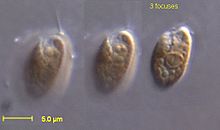Cryptomonad facts for kids
Quick facts for kids Cryptomonads |
|
|---|---|
 |
|
| Rhodomonas salina | |
| Scientific classification | |
| Domain: | |
| Kingdom: | |
| (unranked): |
Hacrobia
|
| Phylum: |
Cryptophyta
|
| Class: |
Cryptophyceae
|
|
Order Cryptomonadales |
|
The Cryptomonads (also called Cryptophyta) are a group of tiny algae. Most of them have special parts called chloroplasts. These chloroplasts help them make their own food using sunlight.
Cryptomonads are very common in freshwater places like lakes and rivers. You can also find them in salty ocean water and places where fresh and salt water mix. Each tiny cell is usually about 10 to 50 μm (micrometers) big. That's super small! They are often flat and have a groove or pocket at one end. Near this pocket, they usually have two flagella. These are like tiny whips that help them swim around.
Some cryptomonads are mixotrophs. This means they can get energy in more than one way. They can make their own food with sunlight, but they can also eat other tiny things.
Contents
What are Cryptomonads?
Cryptomonads are a special kind of single-celled organism. They are part of a big group called eukaryotes. This means their cells have a nucleus and other complex parts. They are very important in water environments. They help form the base of the food web. Many tiny animals eat them.
Where do Cryptomonads Live?
Cryptomonads are found all over the world. They live in many different water habitats. You can find them in cold Arctic waters. They also live in warm tropical seas. They are very common in freshwater lakes and ponds. They can even be found in brackish water. This is water that is a mix of fresh and salty water. Their ability to live in many places makes them very successful.
What do Cryptomonads Look Like?
These tiny algae are usually oval or flattened in shape. They are very small, often invisible without a microscope. Their size is typically between 10 and 50 micrometers. Imagine a human hair; these cells are much, much thinner! They have a unique "gullet" or pocket at the front. This pocket has special structures called ejectisomes. These can shoot out like tiny harpoons. They might help the cryptomonad escape from danger.
How do they Move?
Most cryptomonads have two flagella. These are hair-like structures. They stick out from the front pocket. One flagellum is usually a bit longer than the other. They beat in a special way. This beating helps the cryptomonad swim through the water. It also helps them move towards light. Light is important for making food.
How do Cryptomonads Get Food?
Many cryptomonads have chloroplasts. These are like tiny solar panels inside their cells. They use sunlight to make food. This process is called photosynthesis. It is similar to how plants make their food. The chloroplasts give them different colors. Some can be red, brown, or blue-green.
Mixotrophy: Eating and Making Food
Some cryptomonads are mixotrophs. This means they have a special trick. They can make their own food using sunlight. But they can also eat other tiny particles. They might eat small bacteria or other tiny organisms. This ability helps them survive. They can get food even when there is not much sunlight. It gives them an advantage in different environments.
Images for kids
-
Cryptophytes under SEM
-
Cryptophytes under light microscope
See also
 In Spanish: Cryptophyta para niños
In Spanish: Cryptophyta para niños



